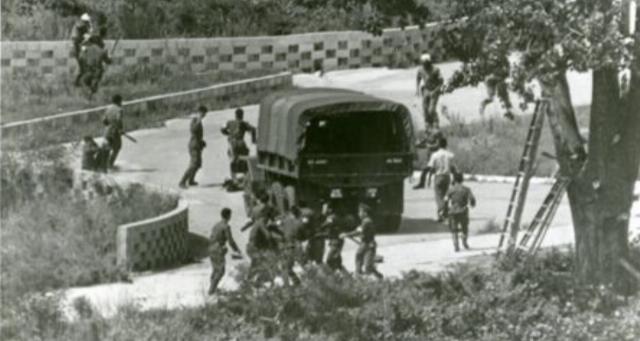Death on the Korean DMZ redux
Today marks the 48th Anniversary of the deaths of two American officers, killed by North Korean soldiers while supervising a tree-pruning detail in Panmunjom, Korea, inside the Korean Demilitarized Zone (DMZ). The events that followed the August 18, 1976 killings nearly sparked the resumption of the Korean War.
Captain Arthur Bonifas, First Lieutenant Mark Barrett, and other U.S. and Korean soldiers, along with the work party, were viciously attacked, battered, and bludgeoned with axes, clubs, and other implements seized by the work party. Paul Cleveland, the Political-Military Officer at the U.S. Embassy in Seoul, Korea, from 1973-1977, recalls:
I well remember that photographs of the murdered officers came to the office; they were horrendous because these guys had been beaten to death. I had never seen such brutality in my life. It was a very tense situation.
Inexplicably, the U.S. Army Casualty Information System available at the National Archives lists both officers as “non-hostile dead: died of wounds or injuries.” Yet, Captain Bonifas was posthumously promoted to Major and received the Bronze Star with V for valor device and the Purple Heart medals. First Lieutenant Barrett received the Combat Infantryman Badge and Purple Heart. An additional nine Purple Hearts were awarded. All are combat decorations.
The following two days saw tense discussions between military and civilian policymakers in Seoul, Korea, and Washington, D.C. General Richard Stilwell, the commander of the U.S. Forces in Korea, started positioning troops to retaliate. The defense condition in Korea was increased to DEFCON 3, increasing force readiness. At the same time, the U.S. Embassy leadership sought a less provocative response.
One of the options, supported by Henry Kissinger, included a limited artillery strike on the North Korean army barracks that housed the soldiers who conducted the unwarranted attack. However, this might trigger a massive artillery counterstrike by the massed North Korean artillery located along the DMZ.
President Gerald Ford directed a less provocative response, cutting the tree down and a show of force that would exhibit U.S. resolve. This included moving military assets to Korea. U.S. Air Force F-4 Phantoms from Okinawa and the Philippines and F-111 Aardvarks from Mountain Home Air Force Base in Idaho were flown in. The USS Midway carrier task force and B-52s from Guam were repositioned to support the effort.
Operation Paul Bunyan was launched early on August 21, 1976. Its objective was to cut the tree down. Engineers equipped with chainsaws were driven to the tree in a small convoy. U.S. Army Joint Security Area personnel were armed with sidearms and pick handles to protect them. An armed infantry company was loaded into Huey helicopters as a quick reaction force. Cobra gunships augmented them. Another infantry company was deployed outside the joint security area armed with pick handles. Other support came from the Korean Army.
Arriving at the tree, the two eight-man engineer teams quickly started cutting the limbs, surrounded by security personnel. Although an estimated 150 to 200 North Korean soldiers approached, they were intimidated by the circling helicopters, the quick reaction force beating the ground with their pick handles, and the Korean Special Forces.
It took approximately 42 minutes to complete the tree-cutting job and withdraw from the Joint Security Area. The only incident reported was when a U.S. helicopter was engaged by North Korean small-arms fire and had to make a precautionary landing. The North Koreans did not retaliate and offered an uncustomary apology for the killings.
War had been averted.
Kevin Mason is a retired Army officer who commanded an infantry company on the Korean DMZ from 1983 to 1984.

Image: U.S. Government
Ad Free / Commenting Login
FOLLOW US ON
Recent Articles
- From Churchill to Vance...Sounding Off About Tyranny
- Globalist Games: They Play, We Pay
- Scorched-Earth Disease Control
- NATO, Ukraine, and the War Hawks’ Pixie Dust Playbook
- On XY in XX’s Sports, Whoopi G. Opens Her Mouth—and Removes All Doubt
- Donald Trump’s Return: A Foreign Policy Reset After Biden’s Weakness
- The Danes and the Greenlanders: How They See Trump's America
- The USAID Case: Judge Amir Ali’s $2 Billion Defiance Escalates
- Terrifying Tariffs: Tax Policy as Back-Door Foreign Aid
- Dr. Marty Makary’s ‘Blind Spots’ Book Is At Odds With Established Findings
Blog Posts
- UN climate change conference to be held in Amazon rainforest, trees sacrificed
- I’m all broken up about Mahmoud Khalil’s rights
- Destuction's defenders
- Go away, Randi
- After blowing $9 billion on 'free' health care for illegals, California's Gov. Gavin Newsom asks for a bailout
- Trump throws down the gauntlet to the out-of-control federal district court judges *UPDATED*
- Ronald Reagan also had a slow economic start
- Getting the left out of the political wilderness
- Oregon selects a trans-turtle and a trans-meteor to sit on a ‘mental health advisory board’
- Fly the DEI skies...and hope that you land safely
- This 70-year-old woman is serving 9 years in prison
- Stacey Abrams really, really, wants 'her' $2 billion from Biden's EPA slush fund
- The (un)masked magician’s apprentice
- Schumer’s attempted shutdown will backfire bigly
- The Democrats are so passionate ...






